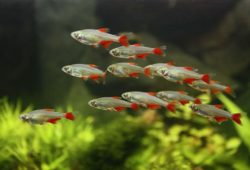Cleaning your aquarium
This article tells you about Cleaning your aquarium. In an aquarium we see fish swimming around and plants growing all of which appear healthy and happy. However, what is actually occurring in the water is a mix of production and consumption and actions and reactions which if not monitored and kept in balance can lead to an unhealthy aquarium, full of algae and stressed fish. Cleaning an aquarium incorrectly is one of the common causes of fish loss and an unhealthy aquarium, the following is a basic guide to cleaning your aquarium correctly.

No matter what fish you choose to keep, or filter you own, the most important part of successful fish keeping is to carry out a regular exchange of water in the aquarium. Over time, wastes from the fish and other organisms in your tank form and when they build up, your aquarium can become unsightly and this environment is also conducive to disease causing pathogens and can result in an increase of disease in your fish.
We recommend that you exchange at least one third of the water in your aquarium every two weeks. Many people wait several months and then change all of the water but this is stressful for both you and the fish and many fish die a few days after this is carried out.
Before cleaning turn off all of the electrical items in the aquarium and start by wiping the sides of the aquarium with an aquarium scourer to remove the algae. Doing this allows you to siphon out the dead algae easily.
The accumulation of fish waste in the gravel looks unsightly and is unhealthy. Previously the only way to remove that waste was by stirring it up or emptying the entire aquarium, which we know is dangerous. Fortunately someone who was sick of doing this invented the gravel cleaner. A gravel cleaner is the most effective method of removing water from an aquarium as it separates the dirt from the gravel as it siphons out the water. Anyone can use them, they need no power and they make cleaning an aquarium far less of chore. If you don’t have one, you don’t know what your missing out on!
Once one third of the water has been removed, the new water needs to be conditioned. We use two products here in the store to condition the water. You will need a liquid water conditioner to remove the chlorine and chloramine from tap water and a salt-based conditioner. I can hear you saying “freshwater fish don’t need salt in their water” but a small amount is actually essential to their health and well-being. In fact it can even prevent disease in the fish. There are specific formulas of salt for both tropical and goldfish. After the aquarium has been refilled, the filter and heater can be switched on.
Finally the pH of the water should be checked to ensure that it is in the correct range for the fish that you are keeping. The pH should be tested and adjusted if required about 6 hours after a water change and then tested on a weekly basis.
Although this method sounds like a lot of work, in reality it represents little more than one hour every two weeks for the average 4ft tropical aquarium and far less for smaller tanks. Not much for the amount of satisfaction that you get from a healthy balanced aquarium!



